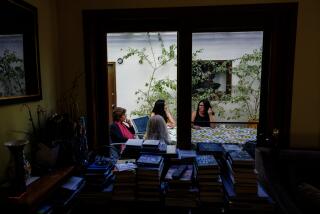O.C. Woman’s Implant Ordeal Sparks Crusade
- Share via
When Marie Walsh tried to tell a federal panel of medical experts in Washington last November how breast implants had shattered her health and her life, the Laguna Hills mother of eight put away her prepared speech, fought back tears, and spoke from the heart.
Walsh wears a lacy top to bed so her husband won’t see the disfigurement resulting from surgeries to correct problems with her breast implants. But she swallowed her pride and pulled out a poster-size color photo of her chest.
The audience at the Food and Drug Administration hearing, filled with satisfied breast-implant recipients who had booed previous testimony against the devices, gasped at the sight of the gruesome photograph and fell silent.
“I told them I want my body back and my life back,” Walsh recalled recently. “My days are filled with pain and my nights with sleeplessness.”
Walsh’s personal courage and her single-minded dedication to persuading the federal government to remove silicone breast implants from the market have inspired other women with similar concerns to join in a nationwide campaign.
From the dining room of her Laguna Hills home, which has become the nerve center of an organization called Breast Implant Information Foundation, Walsh writes newsletters and fields calls from women around the country, many of whom she says are sick and desperately looking for help.
Last Tuesday, the day after the FDA requested that doctors halt the use of silicone-gel-filled implants for 45 days while new information about their safety is analyzed, Walsh was getting about 15 calls an hour. She said she will not rest until breast implants are permanently banned and a way is found to diagnose and treat those to whom she refers as “implant victims.”
Walsh, 45, is very frank about how she once thought a fuller bust line would make her happier. She acknowledged to one stranger on the telephone: “I have grown up a lot and I have learned a lot about myself. Who Marie is has nothing to do with the size of her bust.”
Working at Walsh’s side is Marsha Chambers, a 44-year-old Tustin woman who received silicone gel implants to firm up breasts that sagged after nursing three children. Chambers contends that the implants have made her ill, progressively scarring her lungs so that she is having increased trouble breathing.
Walsh has also suffered, saying that myriad debilitating illnesses, including chronic fatigue, scleroderma and lupus were caused by silicone gel that migrated into her body from a series of ruptured implants. Last February she had the sacks of silicone gel surgically removed for good.
During her testimony before the federal advisory panel, she said her rights had been violated because she hadn’t been warned that such diseases were a risk when she decided to have breast enlargements to correct her naturally lopsided bust line.
Although both women have had their implants removed, most of their symptoms persist, they say, because the chemicals that leaked from them can’t be flushed from their bodies.
In the past 18 months, Walsh and Chambers have disseminated to women and physicians information about silicone that they have gathered from scientific research reports and congressional and FDA files. They have appeared on radio talk shows, “crashed” marketing seminars on breast augmentation, and helped to form support groups in 17 states and Canada. They say they have talked to thousands of women who once thought their medical problems were exceptional to reassure them that they are not “crazy.”
“I take my hat off to them,” said Dr. Sidney Wolfe, director of Public Citizen Health Research Group, a Ralph Nader consumer advocacy organization in Washington that appealed more than a year ago to have the FDA outlaw breast-implant devices.
Noting that many women are embarrassed to even mention in public that they have had breast implants, Wolfe said Walsh’s and Chambers’ “courage is resulting in many other women becoming informed and speaking out. It is a chain reaction.”
Women who have experienced such ailments as arthritic joint pains might not think to question whether the conditions could be associated with breast implants without others like Walsh and Chambers telling their personal stories, he added.
Salvador A. Liccardo, a San Jose attorney representing 200 women across the state in lawsuits against manufacturers of breast implants, praised Chambers and Walsh as “two women who have done a fantastic job in helping to wake up a federal agency to prevent what is becoming a human catastrophe.
“You have 2 million women with silicone implants who are developing diseases at a rapid rate far exceeding their normal occurrence in society,” Liccardo said.
Liccardo said he is representing Walsh and Chambers among more than 50 Orange County women who have filed three separate group lawsuits in Orange County Superior Court that allege violations of product liability laws, negligence, fraud and other charges against Dow Corning Wright, the largest manufacturer of breast implants and the silicone gel used to make them.
Legal challenges, Liccardo said, are forcing implant manufacturers to divulge more data about the safety of breast implants. He noted that the FDA’s current call for a moratorium on the use of silicone gel implants stemmed from information that emerged in another lawsuit that the FDA learned about but has been sealed from the public by judicial order.
Not everyone welcomes what women like Walsh and Chambers are doing. Much of the medical community accuses them of emotionalizing a scientific discussion and ignoring research concluding that breast implants pose relatively little health risk.
“They have a point of view which isn’t held by the mainstream of medicine, including the American Medical Assn., the College of Surgeons and the American Cancer Society, all of whom agree that there is a lot of value in” breast implants, said Dr. Garry Brody, a clinical professor at the USC School of Medicine and secretary of the American Society of Plastic and Reconstructive Surgeons.
“I really think they have created some unnecessary anxiety among the vast majority of women who have had a good result,” Brody added. “They have created an environment in which women blame everything that happens to them on the implant where there is no medical justification for it.”
Chambers said she first got in touch with Walsh in February, 1990, at the suggestion of her mother, who had read the newspaper account of an $80,000 settlement that Walsh won against the manufacturer of one of her ruptured breast implants and recognized that the two women shared similar medical problems. Chambers and Walsh agreed to meet one night at a coffee shop in Santa Ana, where they immediately decided to start a support group.
To see how many women might be interested, Chambers placed a tiny ad in the Tustin News “and within three weeks I had 30 calls from women in Tustin and Irvine,” she recalled.
Over the months, a growing number of women have attended the Orange County support group’s monthly meetings, and now 300 women are on the Breast Implant Information Foundation’s mailing list.
The foundation, which is in the process of incorporating as a nonprofit organization, has built referral lists of physicians and lawyers for women who want medical or legal assistance. But Walsh said her dream is to raise enough money through donations, possibly with the help of Hollywood celebrities, to establish a diagnostic center in Orange County to evaluate and treat the illnesses of women who have breast implants. She said she already has found doctors who would be willing to practice at such a center.
Walsh and Chambers acknowledge that their organizational work has taken an emotional and financial toll on their families. Walsh, formerly a securities broker, and Chambers, formerly a secretary, are unemployed and on disability because of their illnesses.
The combined stress from their illness and volunteer work, the women said, at times has even threatened their marriages.
Walsh’s husband, Jim, says he is proud of his wife’s dogged persistence, but acknowledges that three months ago he was “totally exhausted, angry and mad” that she had become so consumed by the cause, which sometimes takes her out of town and leaves him with their large family and household duties to contend with alone.
Usually when he or the children see Marie, he said, she is talking on one of the household’s three telephones, which ring incessantly from early in the morning often until 1 a.m. or later.
He said his wife’s illness sometimes has kept her in bed for several days, and when her arthritis becomes too painful, he has to help her into the bathroom and turn the knobs in the shower. But after rest and pain medication, she bounces back.
“It hasn’t been a piece of cake,” Marie Walsh acknowledged. “But the rewards of being able to help so many women has far exceeded the struggles of paying bills. The women are crying on the phone. They are sobbing, asking for help and saying, ‘I’m so glad you are there.’ As a human being I could not turn my back.”
More to Read
Sign up for Essential California
The most important California stories and recommendations in your inbox every morning.
You may occasionally receive promotional content from the Los Angeles Times.










